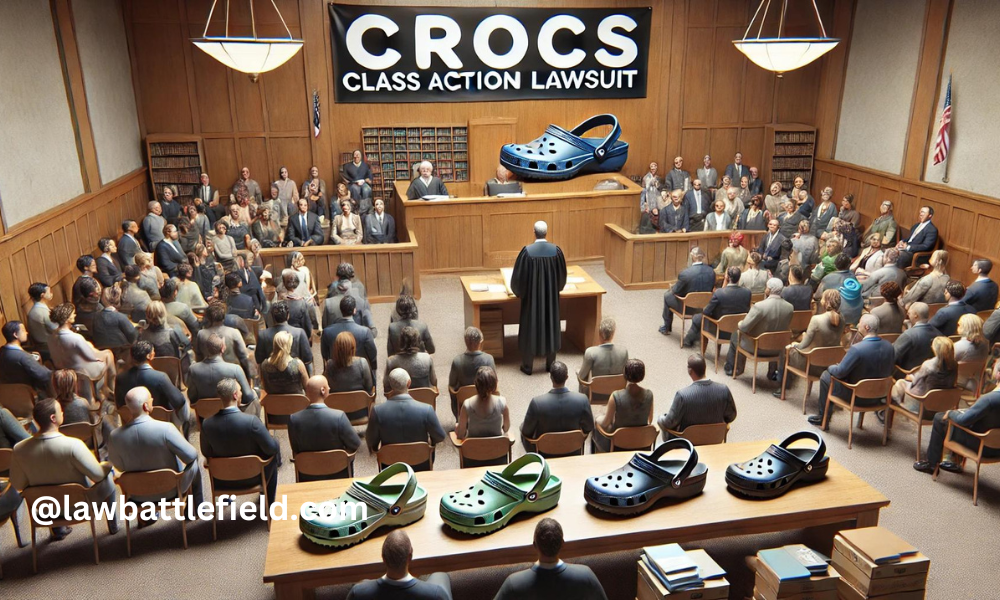Introduction To The Crocs Class Action Lawsuit
The Crocs class action lawsuit involves legal action against Crocs Inc., a company well-known for its popular foam clogs. The lawsuit claims that Crocs shoes shrink when exposed to heat, sunlight, and water, making them unwearable. Customers have reported that their Crocs became too small after just a few uses outdoors, especially in warm conditions.
This issue has caused frustration among consumers who purchased the shoes expecting them to be durable and suitable for outdoor activities. The lawsuit alleges that Crocs misled customers by marketing these shoes as water-friendly and suitable for all-weather conditions without warning them about the shrinkage problem. As a result, many consumers have joined the class action, seeking compensation and holding Crocs accountable for what they believe to be false advertising and a breach of warranty.
In this lawsuit, the plaintiffs argue that Crocs knew about this issue but continued to sell the shoes without proper warnings. The case is currently ongoing in the Northern District of California, where it has gained significant attention from both the media and the public.
This lawsuit is an important case for consumers who have experienced similar issues with their Crocs. It also serves as a reminder of the importance of transparency in product marketing, especially when it comes to products that are used in various environmental conditions. As the lawsuit progresses, affected consumers are encouraged to stay informed and consider joining the class action if they qualify.
Background Of Crocs Inc. And Its Popular Products
Brief History Of Crocs Inc.
Crocs Inc. began in 2002 when three friends, Scott Seamans, Lyndon “Duke” Hanson, and George Boedecker Jr., came together to create a unique, comfortable, and functional shoe. Their idea was inspired by a type of foam clog made by a Canadian company. They saw the potential in these shoes and decided to market them to the public. The original design was intended for boating because of its non-slip sole and water-resistant material, making it perfect for use on slippery decks.
The first Crocs shoe, called the “Beach,” debuted at the Fort Lauderdale Boat Show in Florida in 2002. It was an immediate hit, selling out the 200 pairs they had initially produced. From there, Crocs rapidly gained popularity, not just among boaters but among people from all walks of life who appreciated the comfort and versatility of the shoe.
Introduction To The Crocs Product Line And Croslite Material
Crocs are best known for their distinctive foam clogs, but the company’s product line has expanded significantly since its early days. Today, Crocs offers a wide range of footwear, including sandals, flip-flops, boots, and even sneakers. Despite the variety of designs, all Crocs products share a common feature: they are made from Croslite.
Croslite is a proprietary material that sets Crocs apart from other footwear. It’s not rubber or plastic; instead, it’s a unique closed-cell resin. This material makes Crocs incredibly lightweight, durable, and comfortable. Croslite has natural anti-microbial properties, which help prevent odor. It’s also soft and molds to the wearer’s feet over time, offering a custom fit that many users find exceptionally comfortable.
The use of Croslite is central to Crocs’ identity. This material provides the cushiony feel and the easy-to-clean surface that users love. However, as the ongoing lawsuit suggests, it may have some drawbacks, particularly its tendency to shrink when exposed to heat, which has led to the current legal challenges Crocs faces.
Overall, Crocs Inc. has built its brand on comfort, durability, and versatility, making its products a staple in many people’s wardrobes. The company’s journey from a niche boating shoe to a global footwear phenomenon is a testament to the widespread appeal of its innovative design and materials.
The Allegations Against Crocs
Key Issues Raised By The Plaintiffs
The class action lawsuit against Crocs Inc. centers around several key issues, primarily the shrinkage of Crocs shoes when exposed to heat, sunlight, or water. Plaintiffs in the lawsuit allege that the shoes, made from Croslite material, significantly shrink in size when subjected to these conditions, making them unwearable. Customers have reported that their Crocs became too small after being left in a hot car, exposed to sunlight, or worn in water. This shrinkage issue has led to numerous complaints from consumers who feel misled by the company’s marketing.
The plaintiffs also accuse Crocs of false advertising and misrepresentation. They claim that Crocs marketed their shoes as suitable for outdoor and water activities, giving the impression that the shoes could withstand such conditions without any problems. However, the plaintiffs argue that the company failed to inform consumers about the potential shrinkage, which they see as a critical defect. This omission, they argue, violates consumer protection laws, including laws against deceptive trade practices and false advertising.
Crocs’ Marketing Strategies And The Implied Suitability For Outdoor And Water Activities
Crocs has long promoted its shoes as being versatile and suitable for a variety of environments, including outdoor and water settings. The company’s marketing materials often highlight the durability, comfort, and water-friendly nature of its footwear. Terms like “water shoes,” “beach sandals,” and “all-terrain” have been used to describe Crocs products, leading consumers to believe that these shoes are ideal for outdoor adventures, beach outings, and water-related activities.
However, the lawsuit argues that these marketing claims are misleading. The plaintiffs believe that Crocs should have disclosed the risk of shrinkage when the shoes are exposed to heat or water. By failing to do so, they contend that Crocs misrepresented the true durability and functionality of its products, causing customers to purchase shoes that did not meet their expectations.
Legal Proceedings And Current Status
Timeline Of The Lawsuit
The legal battle against Crocs began with the filing of the class action lawsuit in the Northern District of California. The case, officially known as Valentine, et al. v. Crocs Inc., was initiated after numerous consumers came forward with complaints about their Crocs shrinking. The plaintiffs are represented by the law firm Gutride Safier LLP, which specializes in consumer protection cases.
In response to the lawsuit, Crocs filed motions to dismiss the case, arguing that the plaintiffs’ claims were insufficient. However, U.S. District Judge Trina L. Thompson denied these motions, allowing the lawsuit to proceed. This ruling was significant because it indicated that the court found merit in the plaintiffs’ allegations, at least enough to move forward with the legal process.
Class Certification Motion And Its Implications
One of the critical steps in this lawsuit is the motion for class certification, which was filed by the plaintiffs’ attorneys. If granted, this motion would officially recognize the lawsuit as a class action, meaning that all affected consumers who purchased Crocs and experienced shrinkage could be part of the lawsuit. This would increase the scope of the case and potentially lead to a larger settlement or verdict.
Class certification would also raise the stakes for Crocs, as it could lead to higher litigation costs and the possibility of significant financial liability. If the court grants class certification, the lawsuit would likely move toward either a trial or a settlement. A trial could result in Crocs being ordered to pay damages to affected consumers, while a settlement might involve compensation for customers and possible changes to Crocs’ marketing practices to prevent future issues.
Impact On Consumers
Who Is Affected By This Issue?
The Crocs class action lawsuit impacts a wide range of consumers who purchased Crocs shoes that allegedly shrank when exposed to heat, sunlight, or water. These consumers include anyone who bought Crocs products, particularly those made from the Croslite material, which is central to the lawsuit. The affected individuals are those who expected their shoes to be durable and suitable for outdoor and water activities, as advertised by Crocs, but instead found them to be unusable after exposure to certain conditions.
How Consumers Have Experienced The Shrinkage Problem
Many consumers have reported experiencing the shrinkage problem firsthand. Some have shared stories of their Crocs becoming too small after being left in a hot car or worn at the beach. Others have mentioned that their shoes shrank after getting wet or being left in direct sunlight, leading to frustration and disappointment. These experiences have been widespread enough to spark the current lawsuit, as numerous customers felt that their issues were not isolated incidents but rather indicative of a broader problem with the product.
Potential Eligibility For Joining The Class Action
Consumers who have experienced this shrinkage issue with their Crocs may be eligible to join the class action lawsuit. To qualify, individuals generally need to have purchased Crocs shoes during the period specified in the lawsuit and have experienced the shrinkage problem as described in the claims. Typically, those interested in joining the class action will need to provide some form of proof, such as a receipt of purchase or evidence of the damaged shoes. If you believe you meet these criteria, it is advisable to stay informed about the lawsuit’s progress and consider joining if you qualify.
Potential Outcomes And Consumer Remedies
What Plaintiffs Are Seeking In Terms Of Compensation
The plaintiffs in the Crocs class action lawsuit are seeking various forms of compensation. This may include refunds for the purchase price of the shoes, replacements for the defective products, or financial compensation for the inconvenience and loss suffered by consumers. The exact amount of compensation will depend on the outcome of the lawsuit and whether it is settled out of court or goes to trial.
Possible Outcomes Of The Lawsuit
There are several possible outcomes for this lawsuit. If the case goes to trial and the plaintiffs win, Crocs could be ordered to pay significant damages to affected consumers. This might also lead to a recall of the defective products or changes in how Crocs markets and sells its shoes. Alternatively, the case could be settled out of court, with Crocs agreeing to compensate consumers without admitting any wrongdoing.
Another possible outcome is that Crocs might change its practices to address the issues raised in the lawsuit. This could involve better disclosure of potential risks associated with their products, such as warnings about shrinkage when exposed to heat or water. Such changes would help restore consumer trust and potentially prevent similar issues in the future.
For consumers, the outcome of this lawsuit could mean receiving compensation for their losses and possibly seeing improvements in the transparency and quality of products in the footwear industry. As the lawsuit progresses, it’s important for affected individuals to stay updated on the developments and consider their options for joining the class action if they are eligible.
Crocs’ Response To The Lawsuit
How Crocs Has Defended Against The Allegations
In response to the class action lawsuit, Crocs Inc. has taken several steps to defend itself against the allegations. The company has argued that the plaintiffs’ claims are unfounded and that the issues raised do not warrant legal action. Crocs attempted to dismiss the lawsuit by filing motions in court, arguing that the plaintiffs failed to present sufficient evidence to support their claims of shrinkage and false advertising. Crocs contended that the allegations lacked the specificity required to proceed in court, particularly concerning the details of the supposed defect and its impact on consumers.
Their Attempts To Dismiss The Case And The Court’s Response
Crocs filed motions to dismiss the lawsuit, hoping to have the case thrown out before it could proceed further. The company argued that the plaintiffs did not provide enough detailed evidence to support their claims of a widespread defect. However, the court, presided over by U.S. District Judge Trina L. Thompson, denied these motions. The judge ruled that the plaintiffs had presented enough information for the case to continue, stating that the allegations were sufficient to put Crocs on notice of the alleged misconduct.
Judge Thompson’s decision to allow the lawsuit to proceed was a significant setback for Crocs, as it meant that the company would have to defend itself against the allegations in court. The denial of the motions to dismiss indicated that the court found merit in the plaintiffs’ claims, at least enough to warrant further legal proceedings.
Implications For Crocs And The Broader Market
Reputational Risks And Financial Implications For Crocs
The ongoing lawsuit poses considerable reputational risks for Crocs. As a brand known for its comfort and casual style, the allegations of product defects could damage consumer trust. If the lawsuit garners widespread attention, it might lead to negative publicity that could affect Crocs’ sales and brand loyalty. Financially, if Crocs is found liable or if a settlement is reached, the company could face substantial monetary damages. This could impact their profitability, especially if the court orders a recall or replacement of the affected products.
Potential Changes To Product Disclosures And Marketing Practices
As a result of the lawsuit, Crocs may be compelled to make changes to how it markets its products. The company could be required to provide clearer warnings about the potential risks associated with its footwear, particularly concerning shrinkage when exposed to heat or water. This might involve updating product labels, advertising materials, and even the company’s website to ensure that consumers are fully informed before making a purchase. These changes could help prevent future legal issues and restore consumer confidence.
Broader Impact On The Footwear Industry
The outcome of this lawsuit could have implications beyond Crocs, potentially affecting the broader footwear industry. If Crocs is found liable for the alleged defects, it could set a precedent for other companies regarding product transparency and consumer protection. Other footwear brands might take note of this case and proactively update their marketing practices to avoid similar legal challenges. The lawsuit could also lead to increased scrutiny of the materials and manufacturing processes used in the footwear industry, pushing companies to prioritize product durability and consumer safety.
What’s Next? Legal Proceedings and Consumer Actions
What Consumers Should Watch For As The Lawsuit Progresses
As the Crocs class action lawsuit continues to unfold, consumers should keep an eye on several key developments. The case is currently in the discovery phase, where both sides gather evidence and prepare for possible trial proceedings. Important milestones to watch for include any updates on the court’s decision regarding class certification. If the court grants this motion, it will expand the scope of the lawsuit, allowing more consumers to join and potentially increasing the size of any settlement or judgment.
Consumers should also look out for any news about potential settlements. Often, in cases like this, companies may choose to settle out of court to avoid the risks of a trial. If a settlement is reached, it could include compensation for affected consumers in the form of refunds, replacements, or other financial remedies.
Advice For Those Who Might Be Affected And Want To Join The Class Action
If you have experienced issues with Crocs shoes shrinking and believe you may be affected by the allegations in this lawsuit, there are a few steps you can take. First, gather any relevant documentation, such as receipts, photos of the damaged shoes, or records of your purchase. This evidence will be important if you decide to join the class action.
Next, stay informed about the lawsuit by following updates from reliable sources or legal websites that cover class action cases. If the class is certified, instructions on how to join the lawsuit will likely be made available through legal notices or dedicated websites. It’s important to act promptly, as there are often deadlines for joining a class action.
Finally, consider consulting with a legal professional if you have any questions or need advice on your specific situation. Joining a class action can be a straightforward process, but it’s important to ensure that your rights are protected and that you understand the potential outcomes.
Conclusion
Summary Of The Key Points Discussed
The Crocs class action lawsuit has raised significant concerns about the durability and suitability of Crocs shoes, particularly when exposed to heat, sunlight, and water. The lawsuit alleges that Crocs misled consumers through false advertising and failed to disclose the risk of shrinkage, leading to frustration and financial losses for many customers. Despite attempts by Crocs to dismiss the case, the court has allowed the lawsuit to proceed, opening the door for further legal action and potential compensation for affected consumers.
Final Thoughts
This lawsuit is important not only for those directly affected by the shrinkage issue but also for the broader consumer market. It highlights the need for companies to be transparent about their products and to provide accurate information to consumers. For Crocs, the lawsuit poses both reputational and financial risks, and its outcome could lead to changes in the company’s marketing practices and product disclosures.
For consumers, the case serves as a reminder to be vigilant about the products they purchase and to speak out when they feel that a company has not met its obligations. As the lawsuit progresses, it will be crucial for affected consumers to stay informed and take appropriate action if they wish to seek compensation or join the class action. The final resolution of this case could have lasting implications for both Crocs and the footwear industry as a whole.
FAQs
What Is The Crocs Class Action Lawsuit About?
The lawsuit claims that Crocs shoes shrink when exposed to heat, sunlight, or water, making them unwearable. The plaintiffs allege that Crocs misled consumers by marketing these shoes as suitable for outdoor and water activities without warning them about the potential shrinkage issue.
Who Can Join The Crocs Class Action Lawsuit?
Consumers who purchased Crocs shoes and experienced shrinkage may be eligible to join the class action. Typically, you’ll need proof of purchase and evidence of the damage, such as photos or receipts, to qualify.
What Kind Of Compensation Are The Plaintiffs Seeking?
The plaintiffs are seeking various forms of compensation, including refunds, replacements, or financial compensation for affected consumers. The exact compensation will depend on the outcome of the lawsuit, which could result in a settlement or a court judgment.
Has The Lawsuit Affected Crocs’ Business?
The lawsuit has potential reputational and financial implications for Crocs. If the company is found liable, it could face significant damages and might need to change its marketing practices to prevent future issues.
How Can I Stay Updated On The Progress Of The Lawsuit?
To stay informed, you can follow legal news websites that cover class action cases or visit official legal notice websites. These sources will provide updates on the lawsuit’s status, including any developments in class certification or settlement negotiations.
What Should I Do If I Want To Join The Class Action?
If you believe you qualify, gather any necessary documentation like receipts or photos of your Crocs. Then, stay tuned for updates on how to officially join the lawsuit, which may involve filing a claim once class certification is granted. Consulting with a legal professional can also help clarify your options.
Was this article helpful? Check out more on Lawbattlefield.com
Charleston Asbestos Legal Question: Understanding Your Rights And Options





